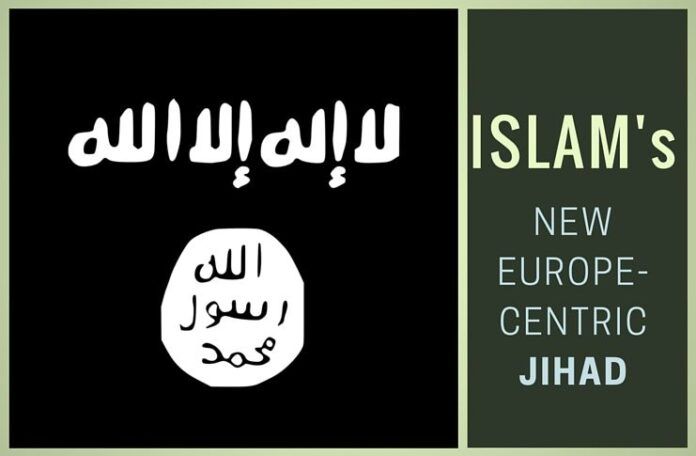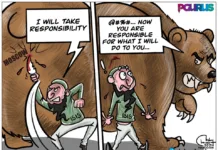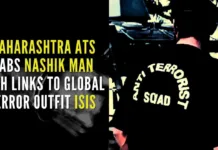
[dropcap color=”#008040″ boxed=”yes” boxed_radius=”8px” class=”” id=””]T[/dropcap]he recent slitting of a catholic priest’s neck in Normandy (July 26, 2016); the weaponization of a truck to mow down 84 persons on Bastille Day in Nice (July 16, 2016); the attack on the French football team in the Euro 2016 Final when French President Francois Holland was in the audience (November 2015); and the Charlie Hebdo massacre in which 12 journalists and policemen were killed (January 2015), suggest that France has entered the embrace of Islamic Jihad, a phenomenon India has long been familiar with.
Given the recent spate of attacks in Germany (stabbings on a train in southern Germany on July 19, 2016 and a suicide attack on the German music festival in Ansbach on July 24, 2016), it is perhaps more appropriate to say that jihad has embedded itself in the soil of Europe.
Gilles Kepel, an expert on Islam and the Arab world, suggested last year that the Charlie Hebdo killings were a ‘sort of cultural 9/11’, a third wave phenomenon, that followed the mujahidin in Afghanistan (the first wave) and the long reign of al-Qaida (the second wave) that emerged simultaneously with the anti-Soviet jihad. What is remarkable about the third wave, according to analyst Jeremy Harding, is that it specifically targets Europe, which has a huge Muslim population – at least 20 million in the European Union nations.
[dropcap color=”#008040″ boxed=”yes” boxed_radius=”8px” class=”” id=””]T[/dropcap]his jihad follows a ‘horizontal’ approach, relying on networks and lone wolf attacks, rather than the familiar terrorist cells (that can be monitored and brought down). The keynote of these attacks is disruption, fear and division. The goal is radicalisation of European Muslims, many of whom are already disaffected and marginalised over events in Muslim lands.
French President Francois Hollande acknowledged the new phenomenon, saying, “Daesh has declared war on us. We have to win that war.” Former prime minister Jean-Pierre Raffarin, head of the Senate’s foreign affairs committee, noted in a Tweet, that: “Everything is being done to trigger a war of religions.”
But it is uncertain if increased French air strikes in Iraq and Syria are the solution. Attacks on Daesh (Islamic State) are unlikely to drive the terrorists outside of France or Europe, when it is the real and perceived attacks on the Arab and Muslim world that has brought terrorism into the heart of Europe.
[dropcap color=”#008040″ boxed=”yes” boxed_radius=”8px” class=”” id=””]T[/dropcap]he United States too, has had some lone wolf attacks, most notably the recent attack on a gay bar in Orlando, Florida (June 13, 2016). These testify to the now almost universal radicalisation of the Muslim community, mainly through the agency of radical imams in every country, and globetrotting evangelical preachers like Zakir Naik, whom Bangladesh has held responsible for the radicalisation of its youth. It may be added that Islamic State has been stepping forward and claiming credit for all recent attacks everywhere, possibly as a tactic to enhance its appeal among potential recruits.
What is common to most attacks is the sheer brutalization of the victims and eye witnesses, who are usually also hostages in the incidents. At the Saint-Etienne-du-Rouvray church in Normandy, the two attackers, wielding knives, interrupted the morning mass and forced Father Jacques Hamel, 85, to his knees and slit his throat before the shocked gathering.
The terrorists took three nuns and two churchgoers hostage. An unidentified victim was stabbed in the hip and throat, but is now in a stable condition. An eye witness, Sister Danielle, later told the media that, “They filmed themselves. It was like a sermon in Arabic around the altar.” Both men were shot by the police when they left the church chanting “Allahu akbar”; one is seriously wounded. One person is said to have been arrested. One terrorist, who was killed, has not been identified so far.
[dropcap color=”#008040″ boxed=”yes” boxed_radius=”8px” class=”” id=””]T[/dropcap]he second, Adel Kermiche, 19, was already under government surveillance after repeated bids to reach Syria, first in March 2015, when he was arrested in Germany. He was placed under surveillance on return to France but managed to escape within two months and was caught in Turkey trying to make his way to Syria, and again returned to France. A former schoolmate has since told the media that Kermiche was a normal teenager who became radicalized after the attack on the satirical Charlie Hebdo magazine in January 2015 and tried to indoctrinate his friends.
Adel Kermiche was reportedly associated with French jihadi, Maxime Hauchard, who appeared in an ISIS beheading video in 2014. The fact that he was able to conduct the terrorist strike with such ease raises questions about the state of French intelligence services at a time when the country has been under an emergency since the Paris attacks of November 2015, which has now been extended for three months.
It is ironical that since 2012, many of those involved in terrorist attacks in France were known to one or other French security body; lack of communication between various departments has proved to be the nation’s Achilles heel. The situation is said to be similar in Germany, where 18 or more security services have poor intra-communication. Obviously, pan-European communication suffers proportionately.
[dropcap color=”#008040″ boxed=”yes” boxed_radius=”8px” class=”” id=””]A[/dropcap]s of now, France has over 10,000 people on the “fiche S” list, which is used to flag radicalized individuals who may be a threat to national security. Citizens are raising questions about the quality of the monitoring programme.
But the more fundamental questions being raised on the streets of Europe pertain to whether Muslims citizens consider religion as their primary identity or can transcend religious identity as Christian Europeans did. Else, there are serious implications for the internal stability of many European countries (and indeed, for all countries with radicalized Muslim populations).
What needs to be emphasised, politely but firmly, is that Jihad has to be acknowledged as mainly “a Muslim problem,” in the sense that overcoming the allure of destructive radicalism is principally a Muslim responsibility in all nations where jihad is a contemporary reality.
- Plagiarism with Pride - November 10, 2018
- “Hindu-ness is the essence of India” – RSS Sarsanghachalak - September 20, 2018
- Lacunas persist in Kathua story - May 5, 2018











Although many analyses appear by many learned writers/thinkers regarding the multifarious destructive effects of Islamic terrorism one hardly comes across the pathogenesis and advent of the malaise which could put an end to this threat to humanity.
Probably in better times before Christianity people minded their own business with no organized religion in operation except Judaism.
With Churchianity gaining precedence over Christ and resultant craze for world dominance through a geographico political aggression veiled in religio spiritual hypocrisy gave rise to the notorious ‘white man’s burden’. Thus Christians consider all non Christians as heathens, living in eternal darkness and their redemption through conversion of faith to the ‘only true’ religion by all possible means.
Trouble arose when another ‘only true’ religion rose in the sky with more radicalized/lethal methods to convert all others out of their fold as Zahils and infidels deserve to follow the teachings in THE BOOK or die.
Things remained somehow under control till 1960s as the Arab/Islamic world was engulfed in poverty/backwardness/illeteracy and ill health.Islamic ire was earlier directed against the weaker and divided territories of Asia including India .
With discovery of abundant oil wealth the Islamic world not only tried to be rich, advanced and enjoy life but helped revive dreams of world dominance through war against imagined or real excesses of the other’ true religion “Christianity”.
This battle of supremacy for world dominance aided by THE BOOK (rightly called terror manual) encourages the believers to kill or die for the cause.It is really surprising that followers of a faith which does not believe in re birth are ready to wait till ‘Quayamat’ to rise from their graves and enjoy the promised luxuries of Zannat .
The terrible terrorism we witness in the western (Christian) world on a daily basis are some of the repercussions against their past excesses against them inspired by the BOOK.
There is a long (black)list of Christians’ torture of the whole humanity in the centuries gone .We should get rid of the impression that the oh so good Christians are getting killed by similar thugs now as they too must be atoning for sins of their fore fathers.
However to come to the present problem , it can only be eliminated when the last copy of ” THE BOOK” of the religion of peace disappears from the face of the earth and humanity does not remember a single word of it as in the case of Bharatiya Shrutis and Smritis.